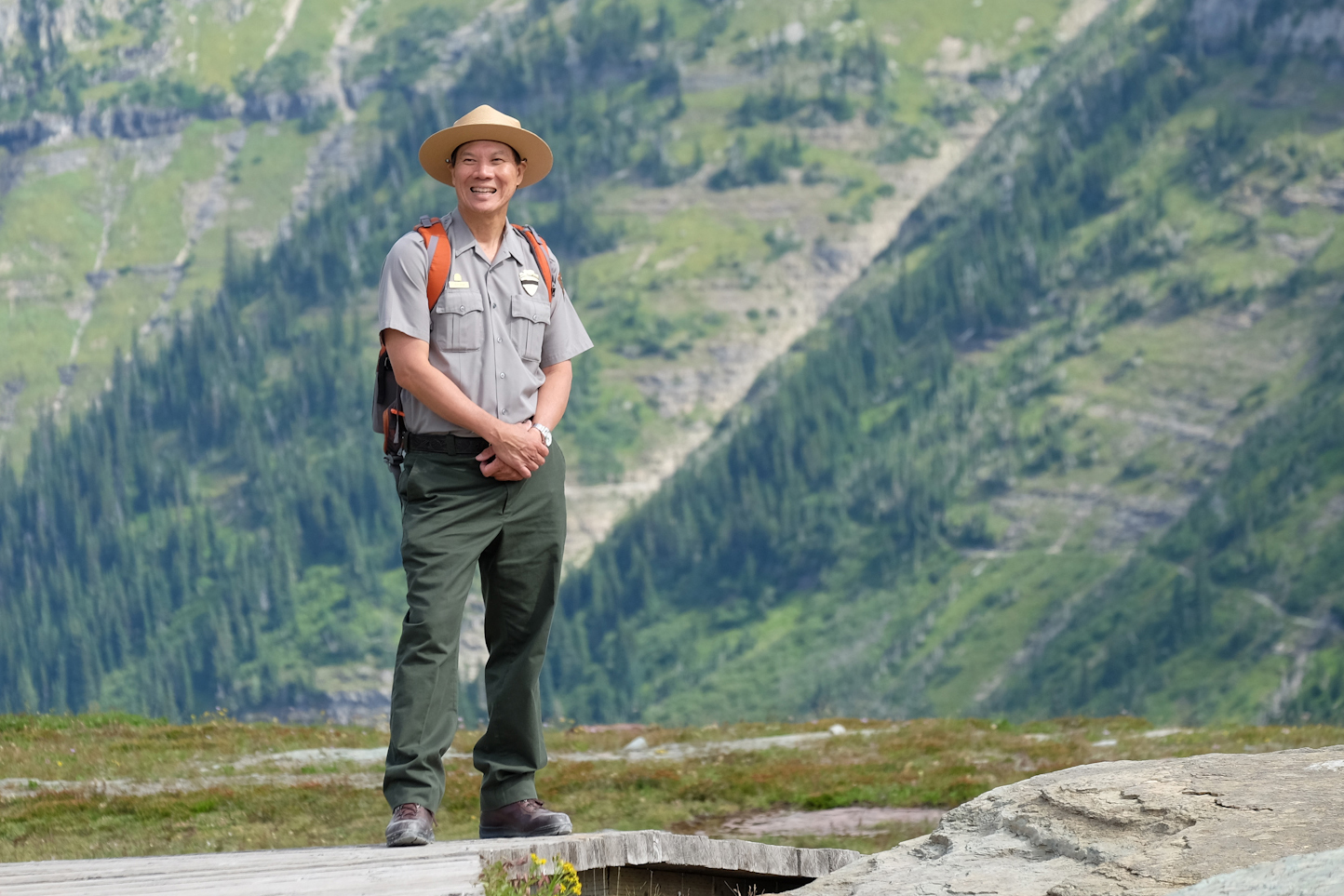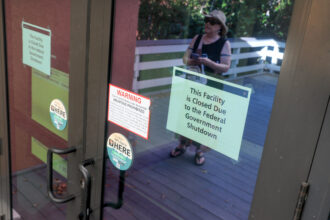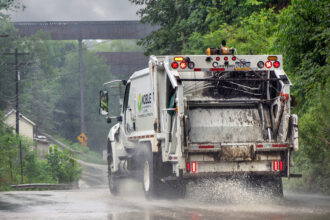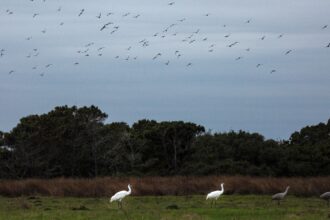COLUMBIA FALLS, Mont.—Glacier National Park’s Going-to-the-Sun Road, completed in 1933, weaves past meandering streams, expansive valleys, stoic limestone peaks and receding glaciers. Jeff Mow, Glacier’s former superintendent, knows the road’s spectacular vistas well, but this fall he used it to provide a glimpse into a much grimmer picture: how the federal government shutdown impacts national parks across the country.
“Parks aren’t designed to operate during shutdowns, you’ll never have enough staff, you can’t provide for visitor safety,” he said. “But if you have to have parks open, I think you’re gonna have to have partners to help do some of those things that might otherwise be inherently governmental.”
Mow’s words have proved prescient, with states and nonprofits stepping in to help national parks operate during the record lapse in federal spending (Glacier, to Mow’s knowledge, is not requesting or in need of such support). Almost every national park has at least one partner organization, a nonprofit that provides support ranging from philanthropic giving to educational or retail services, and some have multiple. Many of those groups are weighing how best to support the parks they are affiliated with.
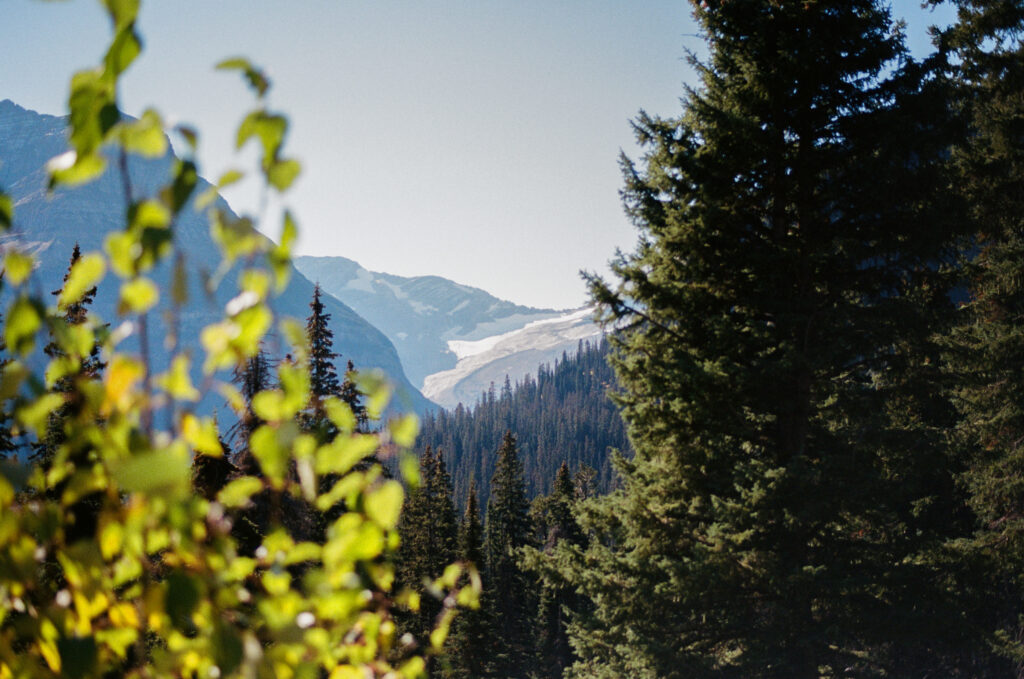
But there are concerns the assistance could be used to justify additional staffing cuts at parks, as members of President Donald Trump’s administration discussed further downsizing federal agencies during the shutdown.
In an October conversation with the Foundation for Defense of Democracies, a national security think tank in Washington, D.C., Interior Secretary Doug Burgum described how cabinet officials in the Trump administration are viewing the shutdown’s impacts on personnel needs.
“Maybe we’re actually able to run with a lot less resources,” he said. “Maybe [the shutdown is] actually helping us get to the point where we could say, ‘you know, we don’t need as many people, we don’t need as much cost.’”
More layoffs in the Interior Department—potentially more than 2,000—are currently “on hold,” according to a Nov. 4 filing made by Rachel Borra, the department’s chief human capital officer, in the U.S. District Court for the Northern District of California. Last month, Judge Susan Illston blocked the layoffs.
But there is no telling what will happen when the shutdown ends, and the slightest suggestion that national parks can withstand more staffing or resource cuts has advocates worried that the charitable work of states and nonprofits could be misconstrued to justify continuing to reduce staffing in national parks.
“People are wondering what is the downside of us stepping in,” said Katie Nyberg, executive director of the National Park Friends Alliance, a consortium of national parks nonprofit partners. “Are we demonstrating inadvertently that like, ‘oh, look, see, we don’t really need this many people working in the national park system—see, there’s all these other groups who can just come and fill in?’”
Nyberg added that she isn’t just worried about the Trump administration getting the wrong impression that business is going on as usual in the parks. “The visiting public that loves their national parks needs to understand what the consequences [of a shutdown] are,” she said.
Under the Trump administration, Republicans have pushed to sell public lands for private development, and some fear that diminished federal oversight of national parks could ultimately lead to partial privatization.
“I just don’t see how a corporate entity or commercial entity could [run a park] without making them unaffordable,” Mow said. “They would become national parks for those that can afford it, as opposed to all Americans.”
Private entities may not emphasize the education mission inherent in national parks, he added—the Trump administration has already asked Americans to report signage that is “negative”—and they would instead begin to feel more like amusement parks.
And yet, national parks are beloved by a vast majority of Americans—the National Park Service consistently ranks as the most favorably viewed federal agency by the public. States and nonprofits providing aid during the shutdown can be crucial to keeping ecosystems healthy and helping generate tourism dollars for nearby communities.
In Colorado, the administration of Gov. Jared Polis has spent $44,800 since Oct. 24, pulled evenly from the Colorado Parks and Wildlife and the Colorado Tourism Office, to keep two visitor centers at Rocky Mountain National Park open. “In the month of October alone, Rocky Mountain National Park gets over 400,000 visitors,” Polis said in an interview with Inside Climate News. “That is very impactful to the economy of Estes Park to Loveland to Northern Colorado in general.”
“Nothing we’re doing is sustainable. We don’t have a budget to pay $3,200 a day forever.”
— Colorado Gov. Jared Polis
Colorado is always looking for ways to partner with federal agencies on land management decisions, Polis added, but indefinitely filling the gap left by the absence of federal funding is impossible.
“Nothing we’re doing is sustainable,” he said. “We don’t have a budget to pay $3,200 a day forever.” Right now, Colorado plans to stop funding visitor centers at the park on Nov. 13, but the state will monitor visitor levels and funding availability week by week.
As for private businesses or industry taking on new roles in any of Colorado’s parks during the shutdown, possibly with an eye toward privatizing some of a park’s operations, Polis hasn’t seen any signs of it. “That’s not happening,” he said.
But the additional support from states and nonprofits cannot continue forever.
“When Congress falls short in its fundamental duty to fund the federal government, it’s understandable that states and nonprofits would seek to fill in the gaps to try to hold things up in the short term, but that’s not sustainable,” said John Garder, senior director for budget and appropriations at the National Parks Conservation Association. “For anyone else to try to fund or certainly manage them in the long term goes against the entire principle of the parks system.”

It can be risky for partner organizations to help fund park management during a shutdown. During the first Trump administration, Sequoia Parks Conservancy, which has been supporting Sequoia and Kings Canyon national parks for over 80 years, paid to help keep three visitor centers and three park stores open, according to Savannah Boiano, the organization’s executive director. But this decision ultimately backfired, she said, as the revenue Sequoia Parks Conservancy earned was not enough for it to break even. The organization concluded it could not sustain its support and ended the funding after three days.
This time, the shutdown is occurring past Sequoia and Kings Canyon national parks’ peak season and Sequoia Parks Conservancy is not currently providing aid—a decision to support the nonprofit’s self-preservation more than anything else, Boiano said.
“Nobody’s winning here,” she added. “We’re not winning as an organization. The National Park Service isn’t winning, and the public isn’t winning either.”
Boiano said she wouldn’t be surprised if the Trump administration eventually tried to misrepresent the work of nonprofit partners and states during the shutdown as evidence that the federal government no longer needs to be involved in every aspect of running national parks.
“If the alternative is to have commercial operations come in and take on [more management], I would say what we have now is working,” she said. Could it be better? Yeah I’d say it could be better, but it’s not because a commercial operator could do it better.”
There is no one-size-fits-all approach for national parks to manage the shutdown. Some are past their peak visitation season, while others are in the middle of their nicest weather of the year. Some parks have mandates to keep visitor center bathrooms available to the public, or need to monitor entrances to vast swaths of wilderness that could be vandalized.
All of the nation’s 433 National Park Service units, and their corresponding partner organizations, “are trying to make a decision that is locally based and makes sense for them,” said Mow, who, after a 32-year career with the National Park service, now serves on the boards of both the National Park Friends Alliance, and The Coalition To Protect America’s National Parks, which is comprised of former National Park Service employees.
With the government shutdown now the longest in the nation’s history, and seemingly no end in sight, states, nonprofits and national parks continue to navigate how best to manage public lands sustainably. All of this will likely further stretch already beleaguered National Park Service workers, whom Mow believes have been unjustly targeted by the Trump administration.
“A smart leader recognizes it’s the people in the organization that really make it successful and great, and it’s true for the Park Service, “ he said. “Organizational leaders who only look at the bottom line or only look at output and don’t think about the people or don’t focus on the people as part of the success I think are so short-sighted.”
About This Story
Perhaps you noticed: This story, like all the news we publish, is free to read. That’s because Inside Climate News is a 501c3 nonprofit organization. We do not charge a subscription fee, lock our news behind a paywall, or clutter our website with ads. We make our news on climate and the environment freely available to you and anyone who wants it.
That’s not all. We also share our news for free with scores of other media organizations around the country. Many of them can’t afford to do environmental journalism of their own. We’ve built bureaus from coast to coast to report local stories, collaborate with local newsrooms and co-publish articles so that this vital work is shared as widely as possible.
Two of us launched ICN in 2007. Six years later we earned a Pulitzer Prize for National Reporting, and now we run the oldest and largest dedicated climate newsroom in the nation. We tell the story in all its complexity. We hold polluters accountable. We expose environmental injustice. We debunk misinformation. We scrutinize solutions and inspire action.
Donations from readers like you fund every aspect of what we do. If you don’t already, will you support our ongoing work, our reporting on the biggest crisis facing our planet, and help us reach even more readers in more places?
Please take a moment to make a tax-deductible donation. Every one of them makes a difference.
Thank you,


